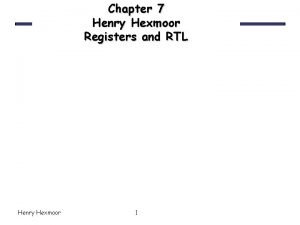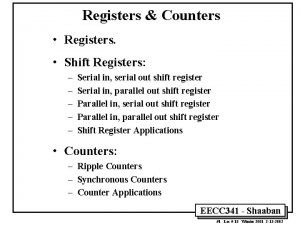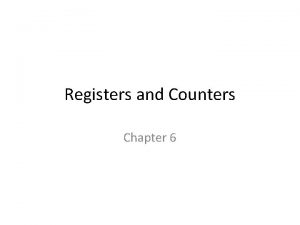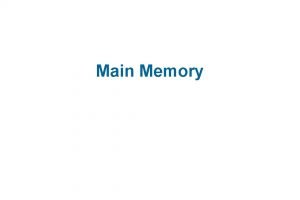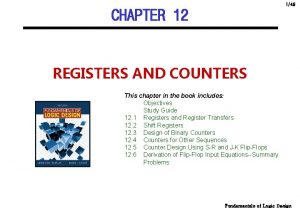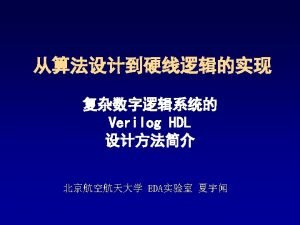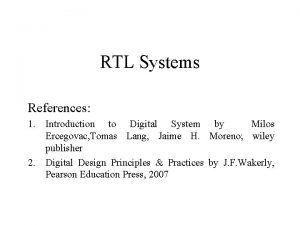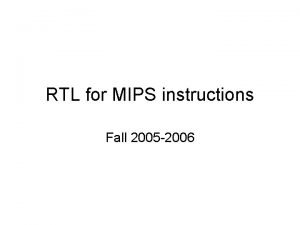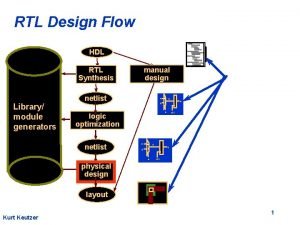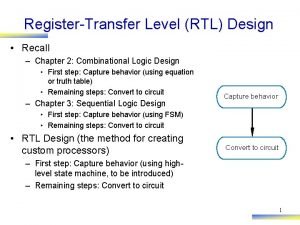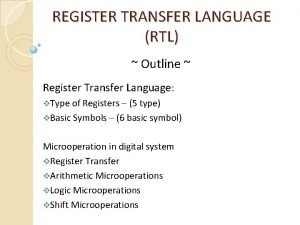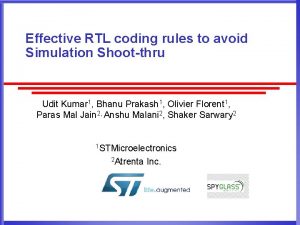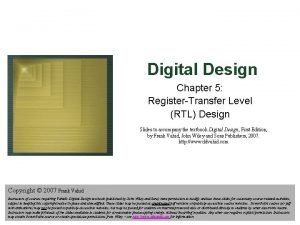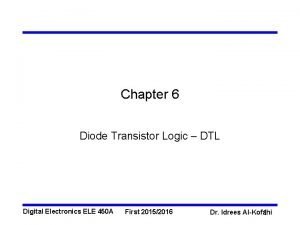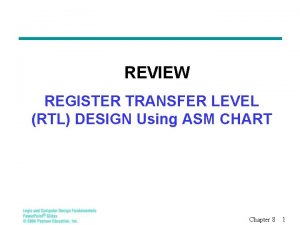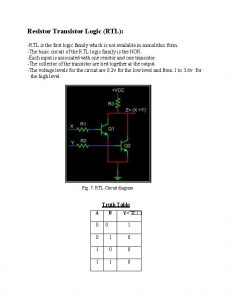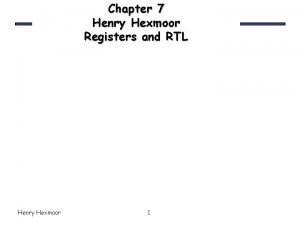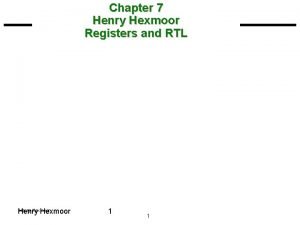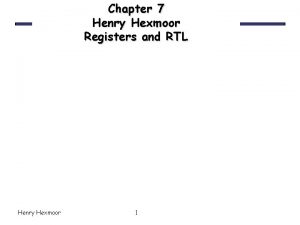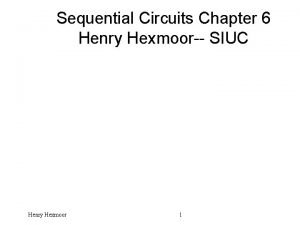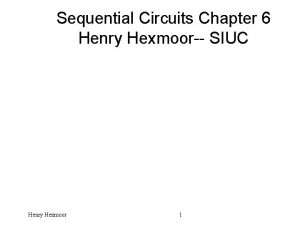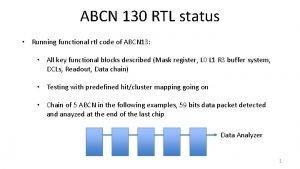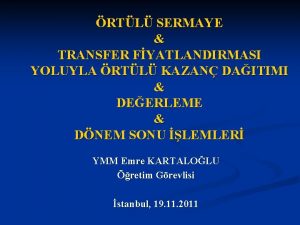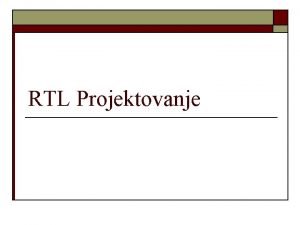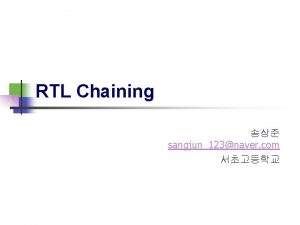Chapter 7 Henry Hexmoor Registers and RTL Henry

















- Slides: 17

Chapter 7 Henry Hexmoor Registers and RTL Henry Hexmoor 1

Registers • • Registers are common sequential devices. – They’re a good example of sequential analysis and design. – They are also frequently used in building larger sequential circuits. Registers hold larger quantities of data than individual flip-flops. – Registers are central to the design of modern processors. – There are many different kinds of registers. – Some applications of these special registers. Henry Hexmoor 2

Benefits of registers • • • Flip-flops are limited because they can store only one bit. – Two flip-flops are used for two-bit counters. – Most computers work with integers and single-precision floatingpoint numbers that are 32 -bits long. A register is an extension of a flip-flop that can store multiple bits. Registers are commonly used as temporary storage in a processor. – They are faster and more convenient than main memory. – More registers can help speed up complex calculations. Henry Hexmoor 3

A basic register • • Basic registers are easy to build. We can store multiple bits just by putting a bunch of flip-flops together! A 4 -bit register is shown on the right, and its internal implementation is below. – This register uses D flip-flops – it’s easy to store data without worrying about flip-flop input equations. – All the flip-flops share a common CLK and CLR signal. Henry Hexmoor 4

Adding a parallel load operation • • • The input D 3 -D 0 is copied to the output Q 3 -Q 0 on every clock cycle. How can we store the current value for more than one cycle? Let’s add a load input signal LD to the register. – If LD = 0, the register keeps its current contents. – If LD = 1, the register stores a new value, taken from inputs D 3 -D 0. Henry Hexmoor 5

Clock gating • We could implement the load ability by playing games with the CLK input, as shown below. – When LD = 0, the flip-flop C inputs are held at 1. There is no positive clock edge, so the flip-flops keep their current values. – When LD = 1, the CLK input passes through the OR gate, so the flipflops can receive a positive clock edge and can load a new value from the D 3 -D 0 inputs. Henry Hexmoor 6

Clock gating is bad • • • This is called clock gating, since gates are added to the clock signal. There are timing problems similar to those of latches. Here, LD must be kept at 1 for the correct length of time (one clock cycle) and no longer. The clock is delayed a little bit by the OR gate. – In more complex scenarios, different flip-flops in the system could receive the clock signal at slightly different times. – This “clock skew” can lead to synchronization problems. Henry Hexmoor 7

A better parallel load • Another idea is to modify the flip-flop D inputs and not the clock signal. – When LD = 0, the flip-flop inputs are Q 3 -Q 0, so each flip-flop just keeps its current value. – When LD = 1, the flip-flop inputs are D 3 -D 0, and this new value is “loaded” into the register. Henry Hexmoor 8

Henry Hexmoor 9

Shift registers • A shift register “shifts” its output once every clock cycle. Q 0(t+1) = SI Q 1(t+1) = Q 0(t) Q 2(t+1) = Q 1(t) Q 3(t+1) = Q 2(t) • • SI is an input that supplies a new bit to shift “into” the register. For example, if on some positive clock edge we have: SI = 1 Q 0 -Q 3 = 0110 then the next state will be: Q 0 -Q 3 = 1011 • The current Q 3 (0 in this example) will be lost on the next cycle. Henry Hexmoor 10

Shift direction Q 0(t+1) = SI Q 1(t+1) = Q 0(t) Q 2(t+1) = Q 1(t) Q 3(t+1) = Q 2(t) • The circuit and example make it look like the register shifts “right. ” • But it really depends on your interpretation of the bits. If you consider Q 3 to be the most significant bit instead, then the register is shifting in the opposite direction! Henry Hexmoor 11

Shift registers with parallel load • We can add a parallel load, just like we did for regular registers. – When LD = 0, the flip-flop inputs will be SIQ 0 Q 1 Q 2, so the register shifts on the next positive clock edge. – When LD = 1, the flip-flop inputs are D 0 -D 3, and a new value is loaded into the shift register, on the next positive clock edge. Henry Hexmoor 12

Serial data transfer • • • One application of shift registers is converting between “serial data” and “parallel data. ” Computers typically work with multiple-bit quantities. – ASCII text characters are 8 bits long. – Integers, single-precision floating-point numbers, and screen pixels are up to 32 bits long. But sometimes it’s necessary to send or receive data serially, or one bit at a time. Some examples include: – Input devices such as keyboards and mice. – Output devices like printers. – Any serial port, USB or Firewire device transfers data serially. – Recent switch from Parallel ATA (Advanced Technology Attachment) to Serial ATA in hard drives… – thin wires help air cooling. . . Henry Hexmoor 13

Receiving serial data • • • To receive serial data using a shift register: – The serial device is connected to the register’s SI input. – The shift register outputs Q 3 -Q 0 are connected to the computer. The serial device transmits one bit of data per clock cycle. – These bits go into the SI input of the shift register. – After four clock cycles, the shift register will hold a four-bit word. The computer then reads all four bits at once from the Q 3 -Q 0 outputs. serial device computer Henry Hexmoor 14

Sending data serially • • • To send data serially with a shift register, you do the opposite: – The CPU is connected to the register’s D inputs. – The shift output (Q 3 in this case) is connected to the serial device. The computer first stores a four-bit word in the register, in one cycle. The serial device can then read the shift output. – One bit appears on Q 3 on each clock cycle. – After four cycles, the entire four-bit word will have been sent. computer serial device Henry Hexmoor 15

Registers in Modern Hardware • Registers store data in the CPU • Used to supply values to the ALU. • Used to store the results. • If we can use registers, why bother with RAM? Answer: Registers are expensive! • Registers occupy the most expensive space on a chip – the core. • L 1 and L 2 are very fast RAM – but not as fast as registers. Henry Hexmoor 16

Registers summary • • • A register is a special state machine that stores multiple bits of data. Several variations are possible: – Parallel loading to store data into the register. – Shifting the register contents either left or right. – Counters are considered a type of register too! One application of shift registers is converting between serial and parallel data. Most programs need more storage space than registers provide. – We’ll introduce RAM to address this problem. Registers are a central part of modern processors. Henry Hexmoor 17
 Henry hexmoor
Henry hexmoor Rtl
Rtl Counters shift registers
Counters shift registers Parallel load
Parallel load Register storage
Register storage Hardware address protection with base and limit registers
Hardware address protection with base and limit registers Registers
Registers Verilog hdl
Verilog hdl Rtl systems
Rtl systems Mips rtl
Mips rtl Rtl hdl
Rtl hdl Rtl design example
Rtl design example Register transfer language example
Register transfer language example Rtl coding
Rtl coding Frank final what be
Frank final what be Dtl logic
Dtl logic One flip flop per state method
One flip flop per state method Resistor transistor logic
Resistor transistor logic
